History
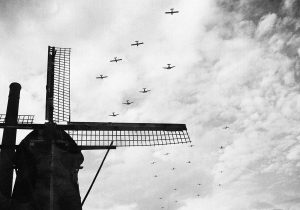 It has been 74 years since 17,740 Americans gave their lives to liberate the people of the Netherlands (often called Holland) from the Germans during World War II, and the people of Holland have never forgotten that sacrifice. For 74 years now, the people of the small village of Margraten, Netherlands have taken care of the graves of the lost at the Margraten American Cemetery. On Memorial Day, they come, every year, bringing Memorial Day bouquets for men and women they never knew, but whose 8,300 headstones the people of the Netherlands have adopted as their own. Of the 17,740 who were originally buried there, 9,440 were later moved to various paces in he United States by their families. “What would cause a nation recovering from losses and trauma of their own to adopt the sons and daughters of another nation?” asked Chotin, the only American descendant to speak on that Sunday 4 years ago. “And what would keep that commitment alive for all of these years, when the memory of that war has begun to fade? It is a unique occurrence in the history of civilization.”
It has been 74 years since 17,740 Americans gave their lives to liberate the people of the Netherlands (often called Holland) from the Germans during World War II, and the people of Holland have never forgotten that sacrifice. For 74 years now, the people of the small village of Margraten, Netherlands have taken care of the graves of the lost at the Margraten American Cemetery. On Memorial Day, they come, every year, bringing Memorial Day bouquets for men and women they never knew, but whose 8,300 headstones the people of the Netherlands have adopted as their own. Of the 17,740 who were originally buried there, 9,440 were later moved to various paces in he United States by their families. “What would cause a nation recovering from losses and trauma of their own to adopt the sons and daughters of another nation?” asked Chotin, the only American descendant to speak on that Sunday 4 years ago. “And what would keep that commitment alive for all of these years, when the memory of that war has begun to fade? It is a unique occurrence in the history of civilization.”
The people of Margraten immediately embraced the Americans, who had come to their aid when they needed it most. The town’s mayor invited the company’s commanders to sleep in his home, while the enlisted men slept in the schools. The protection against rain and buzz bombs was welcomed. Later, villagers hosted U.S. troops when the men were given rest-and-recuperation breaks from trying to breach the German frontier defenses, known as the Siegfried Line. “After four dark years of occupation, suddenly [the Dutch] people were free from the Nazis, and they could go back to their normal lives and enjoy all the freedoms they were used to. They knew they had to thank the American allies for that,” explained Frenk Lahaye, an associate at the cemetery.
By November 1944, two months after the village’s 1,500 residents had been freed from Nazi occupation by the U.S. 30th Infantry Division the town’s people were filled with gratitude, but the war wasn’t over. In late 1944 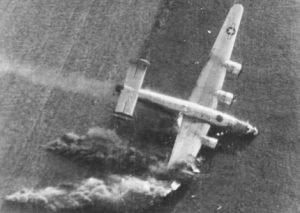 and early 1945, thousands of American soldiers would be killed in nearby battles trying to pierce the German defense lines. The area was filled with Booby-traps and heavy artillery fire. All that combined with a ferocious winter, dealt major setbacks to the Allies, who had already suffered losses trying to capture strategic Dutch bridges crossing into Germany during the ill-fated Operation Market Garden.
and early 1945, thousands of American soldiers would be killed in nearby battles trying to pierce the German defense lines. The area was filled with Booby-traps and heavy artillery fire. All that combined with a ferocious winter, dealt major setbacks to the Allies, who had already suffered losses trying to capture strategic Dutch bridges crossing into Germany during the ill-fated Operation Market Garden.
Now, the U.S. military needed a place to bury its fallen. The Americans ultimately picked a fruit orchard just outside Margraten. On the first day of digging, the sight of so many bodies made the men in the 611th Quartermaster Graves Registration Company ill. The bodies arrived in a procession of trucks and trailers. Death hung in the air over the whole village of Margraten. The sight of so much death caused a few of the people helping with the burials to become ill. They suddenly made a break for the latrines. The first burial at Margraten took place on November 10, 1944. Laid to rest in Plot A, Row 1, Grave 1: John David Singer Jr, a 25-year-old infantryman, whose remains would later be repatriated and buried in Denton, Maryland, about 72 miles east of Washington. Between late 1944 and spring 1945, up to 500 bodies arrived each day, so many that the mayor went door to door asking villagers for help with the digging. Over the next two years, about 17,740 American soldiers would be buried here, though the number of graves would shrink as thousands of families asked for their loved ones’ remains to be sent home, until 8,300 remained, and still, the graves are cared for by the town’s people, as if the dead were their own loved one. Not only that, but they have taken it upon themselves to research the deceased, and learn of their lives as a way of showing honor to these fallen heroes.
On May 29, 1945, the day before the cemetery’s first Memorial Day commemoration, 20 trucks from the 611th  collected flowers from 60 different Dutch villages. Nearly 200 Dutch men, women and children spent all night arranging flowers and wreaths by the dirt-covered graves, which bore makeshift wooden crosses and Stars of David. By 8am, the road leading into Margraten was jammed with Dutch people coming on foot, bicycle, carriages, horseback and by car. Silent film footage shot that day shows some of the men wearing top hats as they carried wreaths. A nun and two young girls laid flowers at a grave, then prayed. Solemn-faced children watched as cannons blasted salutes. The Dutch, Shomon wrote, “were perceptibly stirred, wept in bowed reverence.” All they do for these heroes is because they have vowed never to forget.
collected flowers from 60 different Dutch villages. Nearly 200 Dutch men, women and children spent all night arranging flowers and wreaths by the dirt-covered graves, which bore makeshift wooden crosses and Stars of David. By 8am, the road leading into Margraten was jammed with Dutch people coming on foot, bicycle, carriages, horseback and by car. Silent film footage shot that day shows some of the men wearing top hats as they carried wreaths. A nun and two young girls laid flowers at a grave, then prayed. Solemn-faced children watched as cannons blasted salutes. The Dutch, Shomon wrote, “were perceptibly stirred, wept in bowed reverence.” All they do for these heroes is because they have vowed never to forget.
 During World War II, it seems that there were a number of missed warnings about coming actions. Perhaps, if these warnings had been heeded, parts of the war, and indeed the length of it might have been different. One such event occurred when two German officers who were flying after consuming too much alcohol, became lost in the inky black night sky, when suddenly their plane began to nosedive. Maybe they thought, as their doomed plane plunged toward the ground, “Please let this be German soil we’re hurtling towards.” No matter what their thoughts were, they were definitely not headed for a crash landing in Germany, but rather they crashed in Holland.
During World War II, it seems that there were a number of missed warnings about coming actions. Perhaps, if these warnings had been heeded, parts of the war, and indeed the length of it might have been different. One such event occurred when two German officers who were flying after consuming too much alcohol, became lost in the inky black night sky, when suddenly their plane began to nosedive. Maybe they thought, as their doomed plane plunged toward the ground, “Please let this be German soil we’re hurtling towards.” No matter what their thoughts were, they were definitely not headed for a crash landing in Germany, but rather they crashed in Holland.
The crash landing in Holland was a big problem for the officers, because they were carrying battle plans for Hitler’s coming invasion of Holland. The plans, which involved exotic strategies like flamethrowers, and using gliders to silently deliver troops behind enemy lines, all seemed so unlikely that the 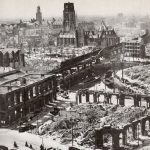 Dutch commanders refused to believe it. Just weeks later, it all unfolded exactly as the plan had foretold. Germany occupied Holland. It seems incredible but almost every daring German offensive was known well beforehand. Yet, in every case, those in power refused to see what was right in front of them. Hitler could have been stopped long before he was, if these botched early warnings had been taken seriously. In another such example, a German deserter was captured by the Russians. He gave up the plans to Hitler’s “Operation Barbarossa.” Yet, the Russian commanders found the 1,800 mile wide offensive too unlikely to believe. Then, just weeks later, they were caught off guard by the largest invasion in history.
Dutch commanders refused to believe it. Just weeks later, it all unfolded exactly as the plan had foretold. Germany occupied Holland. It seems incredible but almost every daring German offensive was known well beforehand. Yet, in every case, those in power refused to see what was right in front of them. Hitler could have been stopped long before he was, if these botched early warnings had been taken seriously. In another such example, a German deserter was captured by the Russians. He gave up the plans to Hitler’s “Operation Barbarossa.” Yet, the Russian commanders found the 1,800 mile wide offensive too unlikely to believe. Then, just weeks later, they were caught off guard by the largest invasion in history.
But, perhaps the most chilling warning of all came far earlier: before the war had even started. The warning came from an analyst dispatched to Hitler’s Germany in 1938. In 1939 he delivered a sobering prediction: the worst conflict in history was about to begin. He reported: “War is coming to Europe, but not until September at the earliest.” On September 1, 1939, Hitler launched his attack on Poland. World 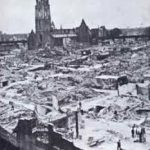 War II had begun. That analyst belonged to a group that soon became part of the largest underground news and research network in the world. One that would go on to predict large world shifts with shocking accuracy: As early as 1987, this network predicted the fall of the Soviet Union. In 1989, they called the crash of the Japanese “miracle.” In the early 90s, they spoke out about the threat of radical Islamic terrorism. In the mid 2000s, they predicted the 2008 financial meltdown. They also predicted Donald Trump’s improbable win in the 2016 Presidential race, which in my opinion was their best prediction. Sadly, this underground news and research group, was not taken seriously in the warnings they gave, and the world paid the consequences for those missed warnings.
War II had begun. That analyst belonged to a group that soon became part of the largest underground news and research network in the world. One that would go on to predict large world shifts with shocking accuracy: As early as 1987, this network predicted the fall of the Soviet Union. In 1989, they called the crash of the Japanese “miracle.” In the early 90s, they spoke out about the threat of radical Islamic terrorism. In the mid 2000s, they predicted the 2008 financial meltdown. They also predicted Donald Trump’s improbable win in the 2016 Presidential race, which in my opinion was their best prediction. Sadly, this underground news and research group, was not taken seriously in the warnings they gave, and the world paid the consequences for those missed warnings.
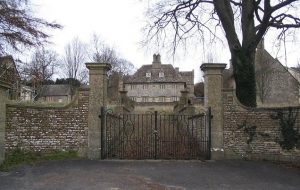 Top secret military bases are common, and have been around longer than most of us would think, but few of them would have been like RAF Rudloe Manor. Most top secret bases had very restricted access, but RAF Rudloe Manor had a way of becoming almost invisible. I’m no expert on top secret bases, and I’m sure that several are underground, but this one struck me as being the best way to hide a military base…ever!! RAF Rudloe Manor is located south-east of Bath. It is just one of several sensitive military installations situated on the Spring Quarries, Copernacre Quarry, the villages of Hawthorn and Hudswell, and the town of Corsham. In World War II the Ministry of Aircraft Production built the Beaverbrook underground aircraft factory here for Bristol Aeroplane and other companies.
Top secret military bases are common, and have been around longer than most of us would think, but few of them would have been like RAF Rudloe Manor. Most top secret bases had very restricted access, but RAF Rudloe Manor had a way of becoming almost invisible. I’m no expert on top secret bases, and I’m sure that several are underground, but this one struck me as being the best way to hide a military base…ever!! RAF Rudloe Manor is located south-east of Bath. It is just one of several sensitive military installations situated on the Spring Quarries, Copernacre Quarry, the villages of Hawthorn and Hudswell, and the town of Corsham. In World War II the Ministry of Aircraft Production built the Beaverbrook underground aircraft factory here for Bristol Aeroplane and other companies.
The area is home to vast caverns, encompassing some 2,250,000 square feet of space, divided into many smaller chambers. Other quarries in the area were expanded and linked together, thereby forming a huge network of tunnels and bunkers. Some parts these tunnels and bunkers were used for army storage purposes.  An RAF Fighter group HQ (RAF Box), and a communications switching center were also set up, making the area an important military nerve center even then. The area also housed the so-called Corsham Computer Centre which while based in Wiltshire, has been alleged to house access to a secret underground city below this English county. Many attempts have been made to gain access to, or at the very least, to confirm of the nature of, this innocent looking facility. Finally, in September of 2000, Sky News was given unprecedented access to this underground city below Wiltshire. The access didn’t specifically mention the Computer Centre as point of entry, however, the news report identified Corsham as the location. As they entered, their camera crews were invited to descend 120 feet below the surface into the previously secret underground city. They saw 60 miles of tunnels, including underground railway stations. Pictures were taken of a recently decommissioned nuclear command bunker. Interestingly, a canteen, which operated in the Second World War, still had murals painted by manufacturing engineers working on the Wellington Bomber engines.
An RAF Fighter group HQ (RAF Box), and a communications switching center were also set up, making the area an important military nerve center even then. The area also housed the so-called Corsham Computer Centre which while based in Wiltshire, has been alleged to house access to a secret underground city below this English county. Many attempts have been made to gain access to, or at the very least, to confirm of the nature of, this innocent looking facility. Finally, in September of 2000, Sky News was given unprecedented access to this underground city below Wiltshire. The access didn’t specifically mention the Computer Centre as point of entry, however, the news report identified Corsham as the location. As they entered, their camera crews were invited to descend 120 feet below the surface into the previously secret underground city. They saw 60 miles of tunnels, including underground railway stations. Pictures were taken of a recently decommissioned nuclear command bunker. Interestingly, a canteen, which operated in the Second World War, still had murals painted by manufacturing engineers working on the Wellington Bomber engines.
They were told that some 4000 personnel were engaged in this secret work at that time. Sky News also transmitted  pictures of massive underground ventilation fans the size of modern jet engines. Why the Government has chosen this moment to disclose this information is anyone’s guess, but the report seemed like a complete U-turn by the military establishment in Wiltshire. Prior to this time, they had remained silent about the claims of underground facilities in this area. As if the act of not talking about it would make the suspicions go away. Still, the very fact that a work-force of 4000 people was able to keep this facility secret for 60 years goes to show how easy it is for Governments to hide their secrets away. And the base looks like just another country manor to this very day.
pictures of massive underground ventilation fans the size of modern jet engines. Why the Government has chosen this moment to disclose this information is anyone’s guess, but the report seemed like a complete U-turn by the military establishment in Wiltshire. Prior to this time, they had remained silent about the claims of underground facilities in this area. As if the act of not talking about it would make the suspicions go away. Still, the very fact that a work-force of 4000 people was able to keep this facility secret for 60 years goes to show how easy it is for Governments to hide their secrets away. And the base looks like just another country manor to this very day.

 When my husband, Bob and I went to Alaska a few years ago, I was hoping against hope that we would be able to see the Aurora Borealis. The likelihood was slim, of course, because they are most often visible in the winter and we were there in the summer. The Aurora Borealis is caused by solar flares, which occur when pent up magnetic energy on the sun’s surface is unleashed in blasts of radiation and charged particles. The resulting explosions are equivalent to the force of millions of hydrogen bombs, and the solar winds they create have the ability to wreak havoc on Earth’s atmosphere. That was precisely what happened in late August and early September of 1859, when the planet was bombarded by the largest solar storm on record. The so-called “Carrington Event” was named for the British astronomer, Richard Carrington, and it made the skies glow with shimmering, multi-colored auroras as far south as Hawaii. In Colorado, it was so bright that one witness reported people “could easily read common print” at night. And that was in August and September!! Why couldn’t I have been around to see that one?
When my husband, Bob and I went to Alaska a few years ago, I was hoping against hope that we would be able to see the Aurora Borealis. The likelihood was slim, of course, because they are most often visible in the winter and we were there in the summer. The Aurora Borealis is caused by solar flares, which occur when pent up magnetic energy on the sun’s surface is unleashed in blasts of radiation and charged particles. The resulting explosions are equivalent to the force of millions of hydrogen bombs, and the solar winds they create have the ability to wreak havoc on Earth’s atmosphere. That was precisely what happened in late August and early September of 1859, when the planet was bombarded by the largest solar storm on record. The so-called “Carrington Event” was named for the British astronomer, Richard Carrington, and it made the skies glow with shimmering, multi-colored auroras as far south as Hawaii. In Colorado, it was so bright that one witness reported people “could easily read common print” at night. And that was in August and September!! Why couldn’t I have been around to see that one?
Most of us have seen pictures of the Northern Lights, also known as the Aurora Borealis. The scene is unforgettable offering an entrancing, dramatic, magical display of dancing lights that are varying in color and fascinate all who see it. It’s hard to believe that an explosion on the sun that sends out radioactive magnetic particles into the atmosphere is responsible for this dazzling natural phenomenon. Of course it is quite complicated. If all those particles were able to just hit the Earth, the event would be disastrous. “The aurora is caused by the interaction of high-energy particles (usually electrons) with neutral atoms in earth’s upper atmosphere. This process is similar to the discharge in a neon lamp, or the fluorescence of a television screen. The strongest auroras are quite bright, comparable to moonlight. At the center of the sun, the temperature is 27 million degrees Fahrenheit (15 million degrees Celsius). As the temperature on its surface rises and falls, 
 the sun boils and bubbles. Particles escape from the star from the sunspot regions on the surface, hurtling particles of plasma, known as solar wind, into space. It takes these winds around 40 hours to reach Earth. When they do, they can cause the dramatic displays known as the aurora borealis.” However it all happens, is pretty much irrelevant to most of us, we just like the beauty of the Aurora Borealis, and we will continue to be mesmerized by them.
the sun boils and bubbles. Particles escape from the star from the sunspot regions on the surface, hurtling particles of plasma, known as solar wind, into space. It takes these winds around 40 hours to reach Earth. When they do, they can cause the dramatic displays known as the aurora borealis.” However it all happens, is pretty much irrelevant to most of us, we just like the beauty of the Aurora Borealis, and we will continue to be mesmerized by them.
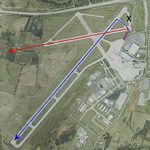
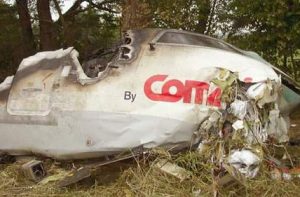 Following instructions and paying close attention to those instructions are crucial to the safe operation of a plane, especially at take offs and landings. When the pilot of Comair Flight 5191 taxied to the runway of his takeoff, something went horribly wrong. He was told to proceed to Runway 22, but he turned one lane too early, and ended up taking off on Runway 26, which was too short for a safe take off of a plane of that size. Comair 1591, was a CRJ-100ER plane that was carrying 47 passengers and 3 crew members. Instead of using runway 22 as expected, they used runway 26 which had too short of a path for a safe takeoff, even though Captain Jeffrey Clay confirmed using runway 22. He inadvertently took a left too early according to the map. At Blue Grass Airport in Lexington, Kentucky, on August 27, 2006, 49 of the 50 passengers and crew died while taking off from the airport. It’s hard to say at what point the pilot knew he was in trouble, but as the plane reached the end of the runway, they knew that there had not been enough time to gt the plane up to speed,and they simply couldn’t get enough lift to get it safely in the air. “They must have almost cleared the fence because only the top of it was missing and then the tips of some trees further out were also burnt off,” said Nick Bentley, who owns the 115-acre farm where the plane crashed, referring to an 8-foot metal fence that separates his property from the airport’s 3,500-foot runway.
Following instructions and paying close attention to those instructions are crucial to the safe operation of a plane, especially at take offs and landings. When the pilot of Comair Flight 5191 taxied to the runway of his takeoff, something went horribly wrong. He was told to proceed to Runway 22, but he turned one lane too early, and ended up taking off on Runway 26, which was too short for a safe take off of a plane of that size. Comair 1591, was a CRJ-100ER plane that was carrying 47 passengers and 3 crew members. Instead of using runway 22 as expected, they used runway 26 which had too short of a path for a safe takeoff, even though Captain Jeffrey Clay confirmed using runway 22. He inadvertently took a left too early according to the map. At Blue Grass Airport in Lexington, Kentucky, on August 27, 2006, 49 of the 50 passengers and crew died while taking off from the airport. It’s hard to say at what point the pilot knew he was in trouble, but as the plane reached the end of the runway, they knew that there had not been enough time to gt the plane up to speed,and they simply couldn’t get enough lift to get it safely in the air. “They must have almost cleared the fence because only the top of it was missing and then the tips of some trees further out were also burnt off,” said Nick Bentley, who owns the 115-acre farm where the plane crashed, referring to an 8-foot metal fence that separates his property from the airport’s 3,500-foot runway.
Shortly after 6am, Comair flight 1591 crashed in a field just half a mile from the Blue Grass Airport in an area of Kentucky known for its horse farms and the Keeneland Race Course. The plane was traveling from Lexington to Atlanta, when it went down. Peggy Young, who lives on Rice Road, near the area where the plane came down, said that just after 6am she and her husband Michael were awakened by the sound of the crash. “There was a loud explosion,” she said in a telephone interview. “We thought it was just a storm, but then we thought it was too loud to be a storm because it had just barely rained. We just were sleeping in when the phone rang and it was Keeneland security and they told my husband there had been an airplane crash.”
First Officer James Polehinke was the only survivor of the crash. He suffered broken bones, a collapsed lung, 
 and severe bleeding. In the end, the ultimate blame was put on the captain, because he didn’t abort liftoff despite questioning his surroundings. Nevertheless, the airport was found to be using outdated maps and had needed to improve runway markings and conditions.So in reality there was blame to go around, and because of the errors, 49 people lost their lives that day in August, twelve years ago. “The whole airport shut down from Aug. 18 to 20,” said Brian Ellestad, the director of marketing and community relations.
and severe bleeding. In the end, the ultimate blame was put on the captain, because he didn’t abort liftoff despite questioning his surroundings. Nevertheless, the airport was found to be using outdated maps and had needed to improve runway markings and conditions.So in reality there was blame to go around, and because of the errors, 49 people lost their lives that day in August, twelve years ago. “The whole airport shut down from Aug. 18 to 20,” said Brian Ellestad, the director of marketing and community relations.
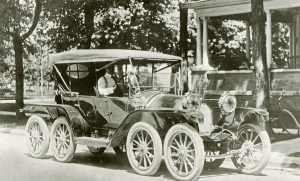
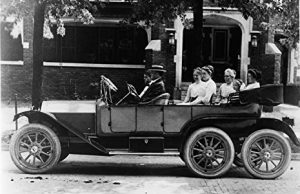 With the invention of the automobile, came the need to make improvements on things like speed, reliability, and looks. Most of the improvements that were made seemed to make sense and improved the automobile, but its been said that, “The line between visionary or eccentric, between progressive thinking, and outright insanity is often quite thin.” During the years when the American automobile industry was rapidly forming, the “unbridled manifestations of a creative imagination” blurred that line on thousands of occasions.
With the invention of the automobile, came the need to make improvements on things like speed, reliability, and looks. Most of the improvements that were made seemed to make sense and improved the automobile, but its been said that, “The line between visionary or eccentric, between progressive thinking, and outright insanity is often quite thin.” During the years when the American automobile industry was rapidly forming, the “unbridled manifestations of a creative imagination” blurred that line on thousands of occasions.
One such “blurring” involved the number of wheels on a automobile. Oddly, that is something that is still under debate today, with the dually pickup. I guess I can see how four wheels on the rear of a vehicle, set side by side, might give more traction, but some of the extra wheels designs of the vehicles in the past, simply made no sense to me. One of the more eccentric of those designs was the eight-wheeled Octoauto. It sported an astounding 180-inch wheelbase. Another example was the six-wheeled Sextoauto, devised by Milton O. Reeves. At the very least, these cars were goofy looking, and the designs seemed to have no exact reason or purpose for the placement of the wheels.
Another example, of the visionary side of the inventive line would be the optional swing away, electrically heated steering wheel available on the 1917 McFarlan. I guess I can see the value in that, especially on a cold winter day. There is nothing worse than toughing a freezing cold steering wheel, except maybe a burning hot one. Benjamin Briscoe of the Jackson, Michigan, based at Briscoe Motor Corporation, straddled the line quite nicely when he built the 1914 models. The 1914 models sported a single Cyclops headlight mounted dead center in the upper radiator shell and laminated paper-mâché body panels…that’s right, I said paper-mâché. The 1916 models sold with four cylinder engines and a promotion proclaiming, “Buy the Four. Use it a month. If then you decide you want the Eight, simply pay the difference and a small installation fee.” Sometimes, what appears to be eccentric today was innovative technology during the first decades of the industry. Promoted as, “The Friction Drive Car” was the 1907 Lambert, a vehicle that served to pioneer the type of transmission capitalized on with the patented developments of Byron Carter.
Between the creation of the first experimental models by William Lambert in 1891 and the companies’ closing in 1917, a wide array of “interesting” vehicles rolled from the companies manufacturing facilities in Anderson, 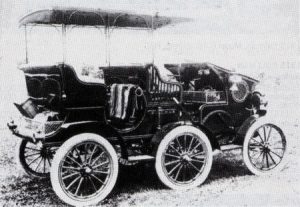
 Indiana. They had engines mounted in the rear, the front, or middle, and came in two-cylinder and four-cylinder configuration, providing power to one or two wheels, dependent on if it were a three-wheel or four-wheel model. I’m sure that along the way there were a number of other interesting and even strange ideas concerning the automobile, but I guess that’s progress, and some of them weren’t progress at all, but a step backward.
Indiana. They had engines mounted in the rear, the front, or middle, and came in two-cylinder and four-cylinder configuration, providing power to one or two wheels, dependent on if it were a three-wheel or four-wheel model. I’m sure that along the way there were a number of other interesting and even strange ideas concerning the automobile, but I guess that’s progress, and some of them weren’t progress at all, but a step backward.
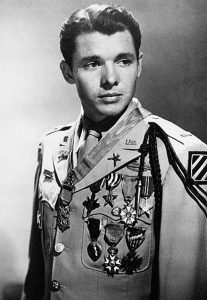 Recently, I found out that I am related to Audie Murphy, who was one of the most decorated American combat soldiers in World War II. As it turns out, he is my 7th cousin 3 times removed, on my dad’s side of the family. We share the same grandfather, Thomas Fuller, who is my 9th great grandfather, and Audie’s 7th great grandfather. Audie became an actor in 1948 and 1969, during which time he was beloved by many people, including my parents. I think they would have been very excited to find out that he was actually related to them, but then I guess they already know it by now. While his acting was impressive, it was his military career that always impressed my parents.
Recently, I found out that I am related to Audie Murphy, who was one of the most decorated American combat soldiers in World War II. As it turns out, he is my 7th cousin 3 times removed, on my dad’s side of the family. We share the same grandfather, Thomas Fuller, who is my 9th great grandfather, and Audie’s 7th great grandfather. Audie became an actor in 1948 and 1969, during which time he was beloved by many people, including my parents. I think they would have been very excited to find out that he was actually related to them, but then I guess they already know it by now. While his acting was impressive, it was his military career that always impressed my parents.
Audie Leon Murphy, was born on June 20, 1925 to Josie Bell Killian and Emmett Berry Murphy in Kingston, Texas. He was born into a large family of sharecroppers. Before long, his father abandoned them, and then his mother died when he was a teenager. Murphy left school in fifth grade to pick cotton and find other work to help support his family. He was a skilled rifleman, and hunting became a necessity for putting food on the table.
After the Japanese attacked Pearl Harbor in 1941, Murphy’s decided that he wanted to help, but he was too young. His older sister helped him to falsify documentation about his birthdate in order to meet the minimum-age requirement for enlisting in the military, because he was only 16 at the time. He was turned down by the Navy and the Marine Corps, so he enlisted in the Army. He first saw action in the 1943 Allied invasion of Sicily. Then, in 1944 he participated in the Battle of Anzio, the liberation of Rome, and the invasion of southern France. Murphy fought at Montélimar and led his men on a successful assault at the L’Omet quarry near Cleurie in northeastern France in October. He received every military combat award for valor available from the U.S. Army, as well as French and Belgian awards for heroism. Murphy received the Medal of Honor for valor that he demonstrated at the age of 19 for single-handedly holding off an entire company of German soldiers for an 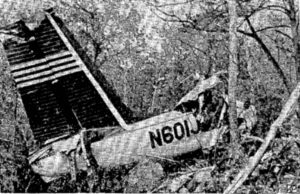 hour at the Colmar Pocket in France in January 1945, then leading a successful counterattack while wounded and out of ammunition.
hour at the Colmar Pocket in France in January 1945, then leading a successful counterattack while wounded and out of ammunition.
After his acting career ended, Murphy, like many actors without work, experienced money problems, but still, he refused offers to appear in alcohol and cigarette commercials, because he did not want to set a bad example. He never let Hollywood take away his high moral standards. Murphy died in a plane crash in Virginia in 1971, shortly before his 46th birthday. Such a sad ending to an amazing life. He was interred with full military honors at Arlington National Cemetery. His grave is one of the most visited sites in the cemetery.
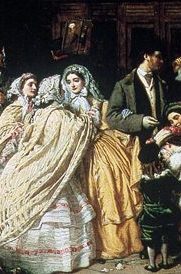 These days, with all the television shows about secret agents, undercover cops, and spies, most of us wouldn’t think twice about one of those positions being held by a woman. During the American Civil War, however, which basically coincided with the Victorian era, one of the most morally repressive eras in history for women, things were different. Everything from a woman’s dress to her education were tightly constricted by moral attitudes that governed her every action. Basically, women were to concentrate their “war efforts” on the task of supporting their husband, brothers, or fathers, in whatever their beliefs were toward the matter. However, as the war dragged on and more men were called into active duty, the farms, factories, stores, and schools were left without workers, so the women stepped up to stand in the gap, as it were. This was most surprising because, back then, women were considered too frail, and their minds too simple for things like politics and war. They were designed for keeping the home and taking care of the babies. Nevertheless, when the men were called into active duty, most of them would have lost their farms, homes, and businesses had it not been for the strength and intelligence of the of the “frail and simple” women. Many women refused to limit their assistance to their country to what could be accomplished close to home. Some of them became nurses, worked to raise supplies for their troops, or even worked in armories, but there was a number of these women decided to support their country in a more dangerous…and scandalous way…they became spies.Back then, espionage was considered a very dishonorable pursuit for a man during the Civil War era, but for a woman…it was tantamount to prostitution. Nevertheless, with the war raging, women of both the North and South flaunted the Victorian morality of the time to provide their country the intelligence it needed to make tactical and practical decisions.
These days, with all the television shows about secret agents, undercover cops, and spies, most of us wouldn’t think twice about one of those positions being held by a woman. During the American Civil War, however, which basically coincided with the Victorian era, one of the most morally repressive eras in history for women, things were different. Everything from a woman’s dress to her education were tightly constricted by moral attitudes that governed her every action. Basically, women were to concentrate their “war efforts” on the task of supporting their husband, brothers, or fathers, in whatever their beliefs were toward the matter. However, as the war dragged on and more men were called into active duty, the farms, factories, stores, and schools were left without workers, so the women stepped up to stand in the gap, as it were. This was most surprising because, back then, women were considered too frail, and their minds too simple for things like politics and war. They were designed for keeping the home and taking care of the babies. Nevertheless, when the men were called into active duty, most of them would have lost their farms, homes, and businesses had it not been for the strength and intelligence of the of the “frail and simple” women. Many women refused to limit their assistance to their country to what could be accomplished close to home. Some of them became nurses, worked to raise supplies for their troops, or even worked in armories, but there was a number of these women decided to support their country in a more dangerous…and scandalous way…they became spies.Back then, espionage was considered a very dishonorable pursuit for a man during the Civil War era, but for a woman…it was tantamount to prostitution. Nevertheless, with the war raging, women of both the North and South flaunted the Victorian morality of the time to provide their country the intelligence it needed to make tactical and practical decisions.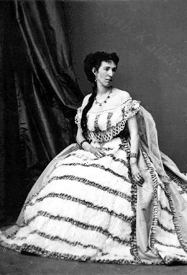
The most famous of these female spies was Belle Boyd…born Marie Isabella Boyd. She began spying for the Confederacy when Union troops invaded her Martinsburg, Virginia home in 1861. One of the Federal soldiers manhandled her mother, and Boyd shot and killed him. She was exonerated in the soldier’s death, and an emboldened Boyd managed to befriend the Union soldiers left to guard her, and used her slave, Eliza, to pass information confided in her by the soldiers along to Confederate officers. Boyd was caught at her first attempt at spying, and threatened with death, but she did not stop her activities. She vowed to find a better way instead. She began eavesdropping on union officers staying at her father’s hotel. She learned enough to inform General Stonewall Jackson about their regiment and activities. Taking no chances, this time, Boyd delivered her intelligence firsthand, moving through Union lines, and reportedly drawing close enough to the action to return with bullet holes in her skirts. The information she provided allowed the Confederate army to advance on Federal troops at Fort Royal. Boyd’s daring acts of espionage soon caught up with her again and when a beau gave her up to Union authorities in 1862, she was arrested and held in the Old Capitol Prison in Washington for a month. Then she released, but found herself in the arrested again soon after. Once again, she managed to be set free, and this time she traveled to England, where amazingly, she married not a Confederate soldier, but a Union officer.
Boyd wasn’t the only spy in the Civil War. Another famous female spy was nicknamed “Crazy Bet,” but her real 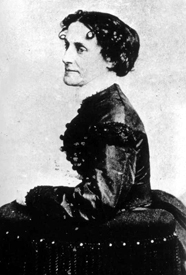 name was Elizabeth Van Lew. Van Lew was born to a wealthy and prominent Richmond family, and was educated by Quakers in Philadelphia. When she returned to Richmond, she had become an abolitionist. She even went so far as to convince her mother to free the family’s slaves. Her espionage activity began soon after the start of the war. Her neighbors were appalled, because she openly supported the Union. She concentrated her efforts on aiding Federal prisoners at the Libby Prison, by taking them food, books, and paper. Later, she smuggled information about Confederate activities from the prisoners to Union officers, including General Ulysses S. Grant. To hide her activities from her Confederate neighbors, she behaved oddly. She dressed in old clothes, talking to herself, and refusing to comb her hair. Believe it or not, people began to think she was insane. They started calling her “Crazy Bet.” Van Lew wasn’t insane, in fact, she was incredibly intelligent. She was hailed by Grant as the provider of some of the most important intelligence gathered during the war.
name was Elizabeth Van Lew. Van Lew was born to a wealthy and prominent Richmond family, and was educated by Quakers in Philadelphia. When she returned to Richmond, she had become an abolitionist. She even went so far as to convince her mother to free the family’s slaves. Her espionage activity began soon after the start of the war. Her neighbors were appalled, because she openly supported the Union. She concentrated her efforts on aiding Federal prisoners at the Libby Prison, by taking them food, books, and paper. Later, she smuggled information about Confederate activities from the prisoners to Union officers, including General Ulysses S. Grant. To hide her activities from her Confederate neighbors, she behaved oddly. She dressed in old clothes, talking to herself, and refusing to comb her hair. Believe it or not, people began to think she was insane. They started calling her “Crazy Bet.” Van Lew wasn’t insane, in fact, she was incredibly intelligent. She was hailed by Grant as the provider of some of the most important intelligence gathered during the war.
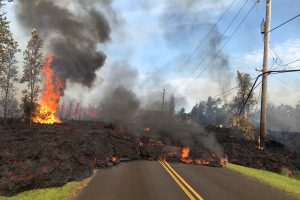 On this day, August 21, 1959, the United States as we know it was completed with the addition of the 50th State… Hawaii. It is the only state that is completely comprised of islands…volcanic islands. Hawaii has another unique feature besides being an island state. That unique feature is that it is the only state that is naturally increasing in size. Most of us immediately think of the current eruptions of Kilauea, and that is a big part of the grown of Hawaii, but it is not the only cause of the growth.
On this day, August 21, 1959, the United States as we know it was completed with the addition of the 50th State… Hawaii. It is the only state that is completely comprised of islands…volcanic islands. Hawaii has another unique feature besides being an island state. That unique feature is that it is the only state that is naturally increasing in size. Most of us immediately think of the current eruptions of Kilauea, and that is a big part of the grown of Hawaii, but it is not the only cause of the growth.
Not every addition to the Big Island involves an eruption that puts people at risk and engulfs their communities. For decades, Kilauea has experienced continuous lava flows through a vent called Pu?u ???? in Hawaii Volcanoes National Park, incrementally adding land to the southeast portion of the island. This continuous flow has added 570 acres of land to Hawaii’s Big Island since 1983, according to the U.S. Geological Survey’s most recent 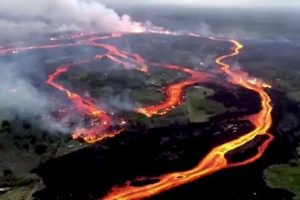 update. Unfortunately, the lava has also buried over 40 square miles of rain forest, communities, and historical sites. Hawaii is an ever-changing place, and the lava doesn’t care about such things as rain forests, communities, and historical sites.
update. Unfortunately, the lava has also buried over 40 square miles of rain forest, communities, and historical sites. Hawaii is an ever-changing place, and the lava doesn’t care about such things as rain forests, communities, and historical sites.
The current stories of the eruption of Kilauea has continued to shock the world, but in reality, Kilauea has been continuously erupting since 1983. Still, on May 3, 2018, the volcano erupted dramatically. The eruption occurred several hours after a magnitude-5.0 quake struck the Big Island. With the eruption came lava flows into residential subdivisions in the Puna district of the Big Island. This prompted mandatory evacuations of the Leilani Estates and Lanipuna Gardens subdivisions. Scientists have two theories about the formation of the Hawaiian Islands. Unlike most volcanoes, the Hawaiian chain sits squarely in the middle of the Pacific plate rather than on a tectonic boundary.
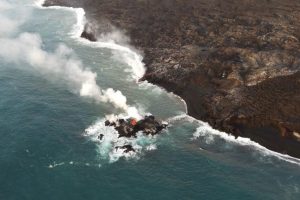
In 1963, J Tuzo Wilson proposed the “hotspot theory” to explain this unusual placement. Wilson proposed that the linear geography of the Hawaiian Islands is due to the movement of the Pacific plate over a stationary point of great heat from deep within the Earth. I have to wonder if that movement is exactly what is causing the current continuing flow of lava from Kilauea. I seems to me that it would be difficult for the lava flow to seal itself when the fault keeps breaking the seal. I could be totally wrong, or I could just be looking at this in a far too simplistic manner. Nevertheless, it seems logical to me. Or maybe that is exactly what Wilson was saying.
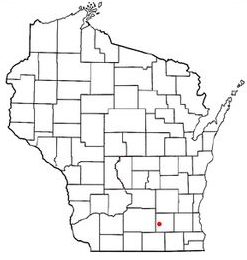 When we think of rain showers, most of us think of a pleasant spring or summer afternoon when the day is hot, and the rain cools things down, and everything smells so good, but on a beautiful April day in 1897 in Jefferson County, Wisconsin, and particularly in the town of Palmyra, the shower they received was not so pleasant. That morning, after a shower overnight, residents woke up expecting to see puddles of rainwater here and there, but instead the sight they saw was appalling. It was like nothing they had ever seen before.
When we think of rain showers, most of us think of a pleasant spring or summer afternoon when the day is hot, and the rain cools things down, and everything smells so good, but on a beautiful April day in 1897 in Jefferson County, Wisconsin, and particularly in the town of Palmyra, the shower they received was not so pleasant. That morning, after a shower overnight, residents woke up expecting to see puddles of rainwater here and there, but instead the sight they saw was appalling. It was like nothing they had ever seen before.
On the ground, the cars, and every other surface in the area were thousands of worms…and they weren’t worms anyone knew about. They were a strange species that was unknown to the area. There was no place that the people could walk without stepping on the disgusting worms. People even had them in barrels that were designed to catch rainwater for drinking, so the drinking water was compromised too. Finally an expert fisherman and gardener, named Captain McDonald, told the people that they were Gilt-Edge Worms. He said that he could tell by their yellow and gold spots and rings. He said that he had used these particular worms for bait while fishing in Ireland.
Well, that was one thing, but Wisconsin is nowhere near Ireland, so how did they get there? Well, the people started to speculate that somehow the worms must have drifted across the ocean in a cloud, but when you think about it, that is an odd thought. Nevertheless, after having watched a story on The Weather Channel about a town that had fish fall out of the sky one time, and that they thought it might have been from a water spout that had scooped them up from a nearby water source, I suspect that something similar might have happened, although I don’t know if the same thing could have happened with a tornado over land, because I doubt if the Gilt-Edge Worm is a water dwelling creature. I don’t suppose they will ever know exactly how the incredible worm shower happened for sure, but while it was a disgusting situation at the time, the townspeople soon decided 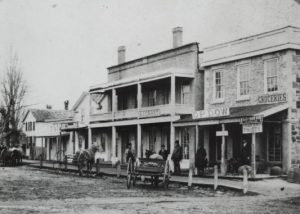 that they might as well make the best of it, and go fishing!!
that they might as well make the best of it, and go fishing!!
The captain told them that Trout found the worms particularly tasty, and hard to resist, especially in the muddy waters after a rainfall, so in very short order, the townspeople decided that it must have been Providence (another word for a gift from God) that brought the worms to their area so miraculously overnight, when trout fishing in the nearby lakes and streams was a universal pastime. So, after finding out about the worms value, I’m sure the people were a little more careful about where they were stepping, so they didn’t kill the worms that might help them catch more trout.

